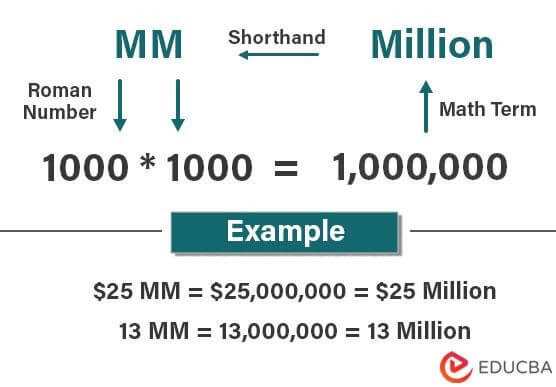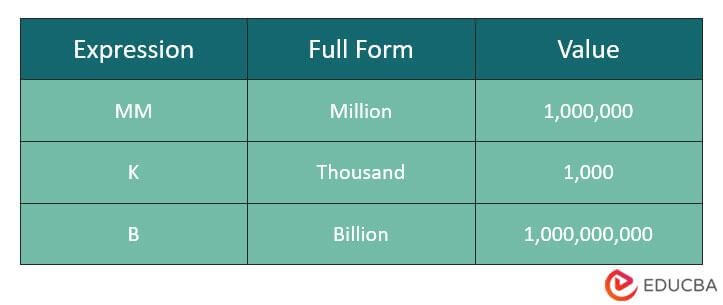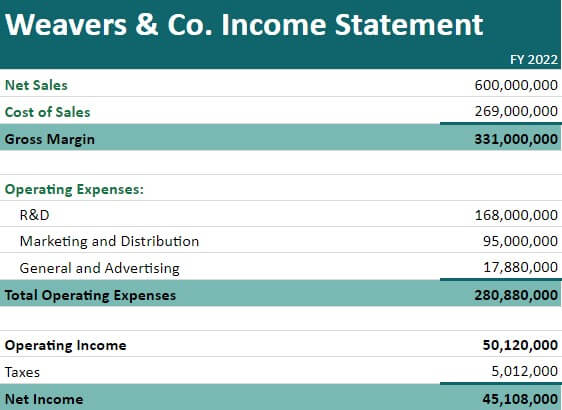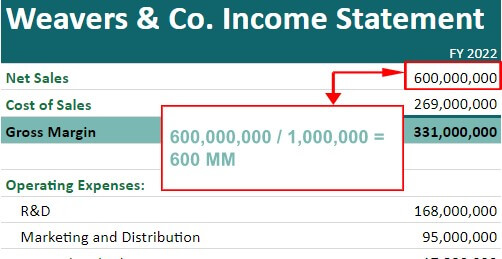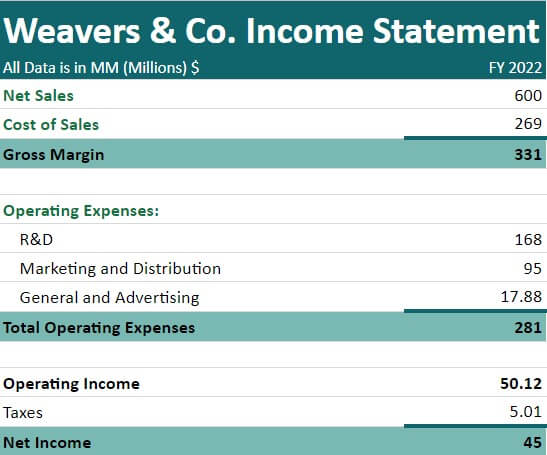Updated July 4, 2023
Definition of MM (Million)
In the world of finance and business, “MM” stands for “million,” which represents the numerical value of one million (1,000,000). This shorthand often refers to large sums of money or market capitalizations, as it takes fewer characters to write “MM” than to write out the complete word “million.”
For instance, if a company reports a revenue of $50 MM for the year 2022, it means that the company earned a total of $50 million for that year. Similarly, if an investor purchases 1 MM shares of a company’s stock, this indicates that the investor has acquired 1 million shares of the company’s stock.
How Does MM (Million) Differ from Other Numerical Expressions?
In numerical expressions, “MM” stands for millions (equivalent to 1,000,000), “K” represents thousands (equal to 1,000), and “B” represents billions (equivalent to 1,000,000,000).
For example, if a company buys 1MM flower bouquets and sells each for 1K, earning 1B, it means they bought 1 million bouquets and earned 1 billion dollars after selling each at 1 thousand dollars.
The table below sums up the differences:
Examples
Example #1
Company A generated total revenue of $450,000,000 last year. The cost of goods sold was $300,000,000, and the operating expenses were $80,000,000. Calculate the company’s net income in millions.
Solution:
A. Convert all the values to million:
Total revenue:
= $450,000,000 ÷ 1,000,000
= 450 MM
Cost of goods sold:
= $300,000,000 ÷ 1,000,000
= 300 MM
Operating expenses:
= $80,000,000 ÷ 1,000,000
= 80 MM
B. Calculate the net income:
Net income = Total revenue – Cost of goods sold – Operating expenses
= 450 – 300 – 80
= 70 MM
Therefore, Company A’s net income for the year was $70,000,000 or $70 MM.
Example #2
A global tech company, Tech&Tech, reported total revenue of $800,000,000 for the fiscal year 2021. Its net income for the same period was $150,000,000. Calculate the company’s net profit margin and express it in MM.
Solution:
A. First, convert the values of revenue and net income from dollars to MM:
Total revenue = $800,000,000 = 800 MM
Net income = $150,000,000 = 150 MM
B. Then, calculate the net profit margin:
Net profit margin = Net income / Total revenue x 100%
= 150 / 800 x 100%
= 18.75%
Therefore, the company’s net profit margin is 18.75%. Then, we simply multiply it by the total revenue:
= 800 x 18.75%
= 150
So the company’s net profit margin is 150 MM.
Example #3
A small-scale clothes manufacturing company, Weavers & Co., records the following data in its income statement. Let us convert the data into a notation of millions for a clear and concise representation.
Solution:
To convert the numerical data, divide it by 1,000,000.
A. First, let’s convert data for net sales:
Net Sales = 600,000,000 / 1,000,000
= 600 MM
B) Similarly, divide the rest of the data by 1,000,000 to get the values as seen below:
Use in Business and Finance
Businesses and finance professionals use MM to express large sums of money and financial metrics. It is used in various ways, such as for market capitalization, revenue, and profit.
1. Market Capitalization: Market capitalization is the total number of outstanding shares in a company’s stock, typically denoted using MM.
Example: if a company has 10 MM shares of stock outstanding, and the current share price is $20, the market capitalization would be $200 million.
2. Revenue: Revenue is the total amount of money a company earns from its operations, and MM is often used to express it.
Example: If a company reports $100 MM in revenue for the year, it means that it earned $100 million in sales over the year.
3. Profit: Profit refers to the amount of money a company earns after subtracting its expenses from its revenue.
Example: If a company reports $10 MM in profit for the year, it means the company made $10 million in excess of its expenses.
Other Meanings of MM
MM can also have other meanings and uses outside of the above-given contexts. For example, it is an abbreviation or acronym for various phrases, such as “military medical,” “multimedia,” and “molecular mass.”
Some of its other meanings are useful in scientific notation and measurements:
1. Millimeter: In lowercase “mm” is the notation for millimeter, which in physics is in the measurement of wavelengths of electromagnetic radiation, such as visible light, X-rays, and radio waves.
For example, the wavelength of infrared ranges between 0.0007 and 1 mm.
2. Megameter: Astronomy expresses distances between celestial objects using “Mm” shorthand for megameters. 1 Mm equals 1 thousand kilometers (km).
For example, the distance between Earth and the Moon is approximately 384 Mm, while the distance between the Earth and the Sun is about 149,600 Mm.
However, it can lead to confusion, particularly in financial contexts. Thus, it is essential to understand the context of using and clarify any potential misunderstandings to avoid confusion.
Calculator
Use the following calculator to determine the million value.
| Numerical Value | |
| Value in MM = | |
| Value in MM = | Numerical Value / 1,000,000 |
| = | 0 / 1,000,000 = 0 |
Frequently Asked Questions (FAQs)
Q1. Is it M or MM for a million?
Answer: The short form expression for a million is MM, while M is the shorthand to represent a thousand.
Q2. What is the full form of MM in a million?
Answer: MM comes from the Roman numeral for one thousand, which is M. So when you see MM, it means “thousand thousand” or “1000*1000.”
Since 1000*1000 is 1,000,000, MM is a shorthand way of writing the number one million.
Q3. What is 5 million in numbers?
Answer: When we talk about “5 million,” we mean 5 times 1 million. And 1 million is equal to the numerical value of 1,000,000.
So, 5 million is equal to:
5 times 1 million
5*1,000,000
=5,000,000 or 5 MM
Recommended Articles
This EDUCBA article simplifies the concept of MM (Million). We explore its meanings, uses, examples, calculation, and more. For more such articles, EDUCBA suggests the following:
